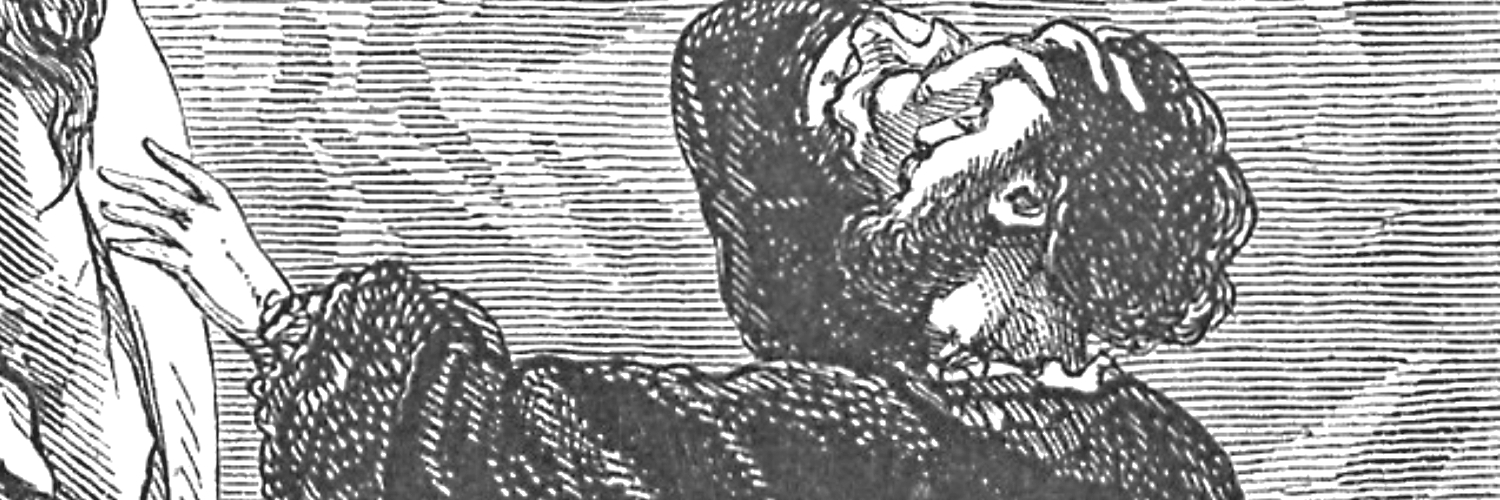On May 25, 1820 Byron reported to Richard Belgrave Hoppner, the British consul at Venice, that he had been sent “heaven knows why several Deutsche Gazettes of all which I understand neither word nor letter.” In them he found what “appear[ed] to be . . . Goethe’s [remarks] upon Manfred,” begging Hoppner to translate them (BLJ VII:106). Hoppner complied, and on June 7 Byron sent the German original, Hoppner’s version, and an Italian one to John Murray, proudly telling him “to keep them all in your archives” because “the opinion[s] of the Greatest man of Germany. . . whether favourable or not are always interesting—and this is moreover favourable” (BLJ VII:113). Hoppner opens:
Byron’s tragedy, Manfred, was to me a wonderful phenomenon, and one that closely touched me. This singular intellectual poet has taken my Faustus to himself, and extracted from it the strangest nourishment for his hypochondriac humour.
Hoppner’s translation may be found in Appendix II, “Goethe and Byron,” LJ, 12: 503-21. The quoted passages occur on p. 506.
Byron had initially inferred that “the word ‘hypocondrish’ [is] any thing but favourable” (BLJ VII:106), and it is on that word that I want initially to focus. The prototypical hypochondriacal hero is the protagonist of The Sufferings of Young Werther, the work that made Goethe famous at twenty-five in 1774, which he omits entirely from his response. Manfred’s cry to the Witch of the Alps, “My pang shall find a voice,” signals the extravagant self-involvement and willfulness of both Manfred and Werther, a condition the authors then seek to disavow, or at least from which they seek to stand apart (II.ii.50)
Already in his late sixties, Goethe read Manfred shortly after its appearance in 1817; his remarks date from that period, though not published until 1820. “Ten years” after the publication of Werther, Goethe “still marvelled at its ‘white-hot expression of pain and joy, irresistibly and internally consuming themselves’” (Boyle 124). Already by the second “genuine” edition of Werther in 1775, Goethe had sought to forestall any simple identification of himself and his suicidal creation, adding the first quatrain of a poem to the title page of Book I that begins “Ev’ry youth for love’s sweet portion sighs, / Ev’ry maiden sighs to win man’s love,” but concludes on the title-page of Book II: "Be a Man, nor seek to follow Me."
Goethe subsequently omitted the poem, but in the revised edition of 1787 the reader’s sympathy for Werther is further distanced by the increased role of the editor who frames Werther’s accounts of his situation by his own addresses to the reader. In addition, Goethe inserts new episodes specifically designed to widen the gap between Werther and the reader. In one added episode a young peasant falls in love with his widowed employer, and, when he tries to force himself upon her and is dismissed by the family, murders the hired hand whom he imagines as his rival. In the editor’s narrative, Werther is shown to have “put himself so completely in . . . [the] place” of the young peasant that he becomes the defender of a would-be rapist and murderer.
A portrait of Werther’s beloved Lotte that is less innocent and more complicitly seductive than in the first version is intensified by a second interpolated tale, in which Werther encounters a madman hunting for flowers to give his beloved, only to discover a day later that the man “was a clerk in the office of Lotte’s father, and it was a passion for her, which he nourished, concealed, revealed, and for which he was dismissed, that drove him mad” (Corngold 71).
These devices enable the reader to see Werther’s limitations and excesses, and so to see the degree to which the “hypocondrisch” is the product of historically specific conditions: the cultural emphasis on sensibility, on the heart, a moment at which Homer, Werther’s first ideal, is contested by the moody Ossian, who “has driven Homer from [Werther’s] heart,” the naive by the sentimental, to use Schiller’s only slightly later terms (Corngold 63).
Most seriously, the hypertrophied inwardness is enforced by the paucity of careers open to Werther: he finds the ambassador for whom he works pedantic, and his way forward is blocked by the aristocratic prejudices of the petty principalities that made up eighteenth-century Germany. Once he asks for his dismissal from court the logic of withdrawal leads swiftly to his declaration: “It is settled, Lotte, I want to die, and I tell you this without romantic excesses, with composure, on the morning of the day when I will see you for the last time” (Corngold 80).
Goethe’s elevation of autobiography into resonant cultural diagnosis—the “me/not me” of literature—was not always grasped by the readers who turned Werther into a Europe-wide fad and lionized him. “[I]t had never occurred to me,” he recalled in 1824,‘that an intolerable torment was vouchsafed for me by sympathizing, well-meaning souls: for instead of someone’s saying something nice to me about my little book, just as it was, they all wanted to know, once and for all, how much of the whole affair was actually true, whereupon I would become very upset and generally say something rude. For to answer this question, I would have had to pluck apart my little book, to which I had devoted so much thought for so long, so as to give its many elements a poetic unity, in the process destroying the form and causing the actual components, if they were not altogether destroyed, at least to be jumbled and scattered. (Aus Meinem Leben, Dichtung and Wahrheit, qtd. Corngold 119)’ The events of 1772 in Wetzlar—his relationship to Charlotte Buff and her fiancé Johann Christian Kestner and the suicide of Karl Wilhelm Jerusalem, who had accompanied Goethe when he met Charlotte, and whose death, Kestner reported, was attributed to love for a married woman —Goethe insisted had been transmuted into a representative fiction, a strong contrast with his response to Manfred. Irked as he was by those who retrojected his novel onto his life, he did the same to Byron.
As he continues his remarks Goethe reduces Manfred to gossip: ‘He has often enough confessed what it is that torments him. He has repeatedly pourtrayed it; and scarcely any one feels any compassion for this intolerable suffering, over which he is ever laboriously ruminating . . . When a bold and enterprising young man, he won the affections of a Florentine lady. Her husband discovered the amour, and murdered his wife; but the murderer was the same night found dead in the street, and there was no one on whom any suspicion could be attached. Lord Byron removed from Florence, and these spirits haunted him all his life after. (LJ XII:506)’ Goethe sidesteps any recognition that Werther had involved him in similar misprisions. For example, Kestner found it difficult to grant the novel independence from the events he and Lotte Buff had lived through with Goethe; he objected to the portrayal of Lotte, insisting that “Lotte’s sharing of Werther’s passion was a dishonourable trait which was not and could not be found in Lotte Kestner,” and his protest at seeing himself resurface in Albert, or at seeing himself seen by others as Albert, is concise: ‘did Albert have to be such a blockhead, “just so that you can swagger up to him and say ‘look what a fine fellow I am?’”’ Kestner himself turns for solace in this charged situation to the third person and the buffer of a foreign language in quoting a friend’s letter to him: “il est dangereux d’avoir un auteur pour ami” (Boyle 185-6).
The authorial imperialism that enabled Goethe to control and reshape the events of his life into his fiction without regard for the effect on other actors in the events Byron repeats in transforming Augusta Leigh, who remained in England to confront the same questions of truth to experience that Goethe acknowledged and Kestner and Lotte Buff face, into the mythical Astarte.
Goethe objects that in Manfred “the gloomy heat of an unbounded and exuberant despair becomes at last oppressive to us” but he concedes: “Yet is the dissatisfaction we feel connected always with esteem and admiration.”
Notwithstanding the tantalizing hints of a confession of incest, Manfred should not, as Jeffrey Cox has recently persuasively argued in Romanticism in the Shadow of War, be wholly inserted into the kind of erotic entanglements that Goethe retails. In both Werther and Manfred, the convergence of the poet’s life and the cultural moment is striking. The emptiness of time Manfred suffers catches the mood of a post-Congress of Vienna, post-Waterloo moment. Byron was not alone in feeling that peace had come but with the restoration of the old regimes revolutionary energies had departed. In Switzerland in 1816, Byron was not only temporally and geographically between Augusta and Annabella and the erotic profusion of Italy and the stability of Teresa Guiccioli; he was also between engagement in Regency politics—Parliamentary speeches on the Frame-breakers, opposition to the Regent—and the rejuvenation offered by joining the Carbonari against Austria and then the Greek Revolution. Manfred’s flamboyant withdrawal from the world acts out the uncertainty of his creator facing a world that failed to inspire commitment.
The textual history that marks Goethe’s effort to cast critical distance on his self-absorbed protagonist has a counterpart in Manfred, though not in the 1817 text that Goethe read. Much of Manfred was drafted by September 1816, but the play was not completed when Byron left Switzerland for Italy. Acts I and II were sent to John Murray by March 9, 1817, when the original fair copy of Act III was also sent.
Self-deprecating comments accompanied the transmissions: “I have no great opinion of this piece of phantasy” (BLJ V:170), “a drama as mad as Nat. Lee’s Bedlam tragedy” (BLJ V:179), and, finally, “I have really & truly no notion whether it is good or bad— . . .You will submit it to Mr. G[iffor]d & to whomsoever you please besides” (BLJ V:185). Byron’s submission to the rejection of Act III by William Gifford, Murray’s literary advisor, grew from an earlier relationship. Gifford had been an early model for Byron, who invokes his couplet satires, the Maeviad and the Baviad, in English Bards and Scotch Reviewers; in 1813, after the overwhelming success of the first two cantos of Childe Harold’s Pilgrimage, Byron was still addressing him as a lowly acolyte: “I feel greatly at a loss how to write to you at all—still more to thank you as I ought.—If you knew the veneration with which I have ever regarded you long before I had the most distant prospect of becoming your acquaintance literary or personal—my embarrassment would not surprize you” (BLJ III:63-4). More than thirty years older than Byron, the former editor of the conservative Anti-Jacobin and then of the Tory Quarterly Review, Gifford epitomized the established values and tastes that Byron’s poetry subverted, but, as late as his time in Missolonghi, Byron angrily rebutted to his banker and friend Douglas Kinnaird the rumor that he was the author of an attack on Gifford, who was rich in enemies: “It is not true that I ever did—will—would—could—or should write a satire against Gifford—or a hair of his head—and so tell Mr. Murray.——I always considered Gifford as my literary father and myself as his ‘prodigal Son’” (emphases in original: BLJ XI:117). When Gifford approved of the first two acts of Manfred but did “not by any Means like the Conclusion,” Murray managed the dilemma by sending the assessment with a cover letter that attributed the condemnation to the “paternal interest” Gifford took in Byron’s “literary well being” (Nicholson 219).
Fathers, however, do not fare well in Byron’s poetry, or rather they fare all too well, habitually crushing the rebellious Byronic hero, and so it is with Manfred. In the original third act, Manfred reacts to the Abbot who menaces him, unless he repents and gives his lands to the monastery, by having him carried off by the demon, Ashtaroth, singing.
Gifford was contemptuous: ‘The Friar is despicable, & the servants uninteresting. The scene with the Friar ought to be imposing, & for that purpose the Friar should be a real good man—not an idiot.—More dignity should be lent to the catastrophe . . . Manfred should not end in this feeble way - after beginning with such magnificence and promise—and the demons should have something to do in the scene. (Nicholson 220)’ Byron wholly capitulated, telling Murray: ‘The third act is certainly d-----d bad . . . It must on no account be published in its present state;—I will try & reform it—or re-write it altogether—but the impulse is gone—& I have no chance of making anything out of it. I would not have it published as it is on any account. (BLJ V:211)’ Within a month Byron had composed a new third act, acceding to Gifford’s strictures point by point: “The Abbot is become a good man—and the Spirits are brought in at the death—you will find I think some good poetry in this new act here & there—& if so print it—without sending me further proofs—under Mr. G[iffor]d’s correction” (BLJ V:219). In making the Abbot a good man, Byron at once severed himself from the Gothic, of which a corrupt and usually lustful monk was a staple, severing himself also from the play’s roots in “an unfinished Witch drama” begun years before and from his experience on the managing committee of Drury Lane Theatre and the hundreds of plays he had read during his tenure (CPW IV:463). In revising, Goethe had similarly ringed Werther with complicating perspectives; Byron’s excision, under pressure from Gifford, is more like repression, and, though it accelerated a shift in Byron’s mode, it came at a cost. In contrast, another stalwart of the Quarterly, J. W. Croker, after reading the first two acts of Manfred, urged Murray to “do all you can to induce Lord Byron to go on with his tragedy—for such I suppose it is to be. Its wildness, or if you will, its extravagance, is to me its first recommendation” (Nicholson 224). Croker, the author of the notorious review of Keats’s Endymion, was in general no fan of the younger poets, but, in singling out Byron’s “extravagance,” he points to a strength Gifford could not recognize, and which the chastening and elevating of the third act sacrificed. At the close Manfred defeats the demons who have come for him by asserting his superiority—“Thou hast no power upon me, that I feel; / Thou never shalt possess me, that I know”—and in this triumph of the will can then quietly die (III.iv.125-6). The new calm for which Byron strove, countering the Titanism of the earlier acts, suffuses his final speech: “Old man! ‘tis not so difficult to die” (III.iv.151). When Byron saw that the 1817 first edition had dropped the speech, he forcefully protested: “You have destroyed the whole effect & moral of the poem by omitting the last line of Manfred’s speaking” (BLJ V:170). In their quest for a grander conclusion, neither Gifford nor Murray had comprehended the significance of the deliberate understatement, an intertextual rebuke to Werther’s elaborate staging of the suicide in which his succumbing to despair climaxes.
After Byron’s death in 1824, Murray obtained the copyrights of the poems that had been too scandalous for him to publish in the poet’s lifetime and brought out in 1832-33 a canon-fixing Works of Lord Byron with his Letters and Journals in seventeen handsome volumes, of which the first six were filled by Thomas Moore’s Life, previously published in 1830. Manfred is in volume 11.
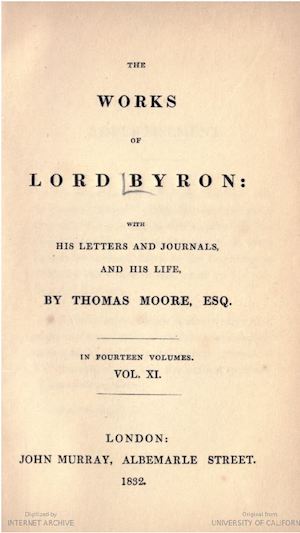
The driving force behind the edition was its editor, John Wright, in whose hands a publication announced on the title page as “in fourteen volumes” when it began to appear seriatim in 1832 reached seventeen volumes when it concluded in 1833. Wright was convinced “that the new management of the Poetry, with the explanatory Notes, etc. will do more for the character of the Lord [Byron] than all the writings respecting him that have hitherto appeared.”
He persuaded Murray to extend Don Juan into a third volume: “I now find it will be quite impossible to do justice to the work, if you persist in compressing the Don Juan into two volumes . . . the Notes, critical, historical, moral, and religious are very numerous, and of a most interesting and fascinating description. I therefore intreat you to allow me another volume for the Poetry.” He failed, however, despite detailed pleading of the commercial advantages, to win Murray’s assent to the proposition that “the work ought to consist of eighteen” volumes (November 1832, MS. 41309). Wright tirelessly sought out those whose lives were entwined with Byron’s, and who might share precious texts. Having obtained manuscripts from Augusta Leigh, he proceeded to Teresa Guiccioli: the Countess, he reported, “feels very sore and angry with Moore, and with reason” and so gave him two volumes of Moore’s Life with corrections (October 8, 1832), emboldening him to propose that Murray intimate to her that ‘The Countess would also be rendering a service to the memory and character of Lord Byron, if she would permit me to look over the original manuscripts of Marino Faliero, Sardanapalus, the early cantos of Don Juan, and any other poems that she may have.’ Wright then unabashedly offered Teresa an enticement: if she were to look over ‘Medwin, Hunt, Blessington, and the rest, and mark in the margin such misrepresentations respecting herself and Lord B, as she may wish to have set right . . . I could turn them to good account. (MS. 41309)’ Turning the publisher, his employer, into his intermediary, Wright offers him too a “good account,” the possibility of what on a later occasion he frankly called “a little sensation . . .[to] add a thousand or two to the sale of the work” (Dec. 3, 1832, MS. 41309).
I have digressed from Manfred, but only to show the editorial practice that shaped the dress in which Byron appeared for the remainder of the century. Wright was the kind of editor who could declare with pride, and perhaps even glee, that he had gone over the fifth canto of Don Juan “and have extracted matter for at least thirty notes” (MS. 41309). I am only partly joking when I comment that his practice is simultaneously that of the Oxford Wordsworth, committed to the author’s final text, and that of the Cornell Wordsworth, committed to the earliest, often manuscript, version. The aim of the set was to establish Murray’s prize poet, but in addition to printing the corrected 1818 text of Manfred and surrounding it with encomia from Francis Jeffrey and Professor Wilson attesting to its gravitas, the edition prints the correspondence in which Gifford condemned the original third act—and the rejected act itself, as in this example:
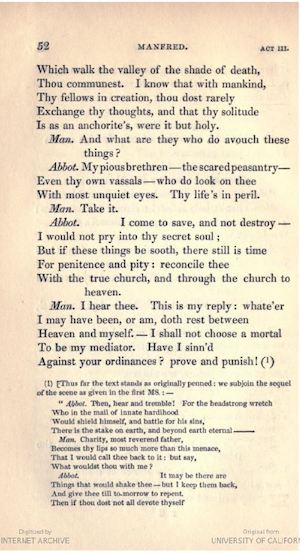
The consequence is that the calm of the final text achieved on the page is continuously disrupted by the return of the repressed in the notes below: an edition intended to monumentalize Byron instead preserves the hypocondrish turmoil from which it emerged. Other traces of the gestation of the drama remain. Declaring in 1820 that he had never read Goethe’s Faust but acknowledging that “Matthew Monk Lewis in 1816 at Coligny translated most of it to me viva voce,” Byron maintained that “it was the Staubach & the Jungfrau—and something else—much more than Faustus that made me write Manfred” (BLJ VII:113). The “something else” has usually been understood as the hinted incest with Augusta, which makes the edition’s note in Act I showing the closeness of the drama to excerpts from “the Journal of his Swiss tour, which Lord Byron transmitted to his sister,” perhaps indelicate (21n1). Murray was “much struck with your description of pastoral life in the Alps - wch [sic] I hope you do not omit & indeed as much of the first impressions made by the Scenery will be given as you can - all the world has been there & will be delighted to tread the Air again in imagination” (Nicholson 217). The Alpine sublime was a commercial imperative on which Murray did not fail to capitalize in the frontispiece to the volume by J. M. W. Turner.
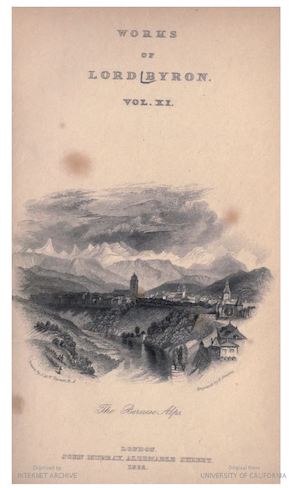
Even more than Murray, Wright understood that as most of the poetry had been previously published, the success of the edition depended on the added value of the apparatus and especially the illustrations. He wrote Murray that even when they pictured familiar places, such as Venice, “they may be so varied as to give them an air of novelty” (MS. 41310). Every volume had not one but two frontispieces. On Monday, November 26, 1832, Wright implored Murray: “Turner should be induced to do something very striking for the 14th volume. This is, I assure you, of great importance” (MS. 41309). In the first frontispiece, Turner, working from a sketch by W. Page, provides a bland view of Parnassus and the Castalian Spring, in the second a dramatic view of the Battle of Waterloo from the perspective of Hougoumont, appropriate to the review of the end of Napoleon’s career and the Congress of Vienna in “The Age of Bronze,” contained in the volume.
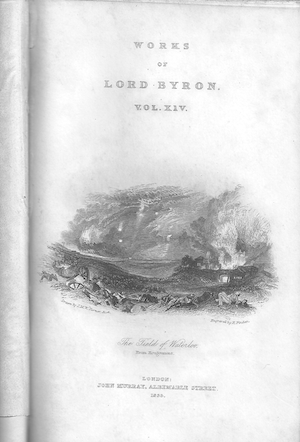
I rehearse these familiar materials to suggest that, when Alfred Bunn decided in 1834 to produce at Covent Garden a stage version of the drama that Byron claimed he had “rendered . . .quite impossible for the stage,” he did not have to look far for the materials of sensational stage display (BLJ V:170).
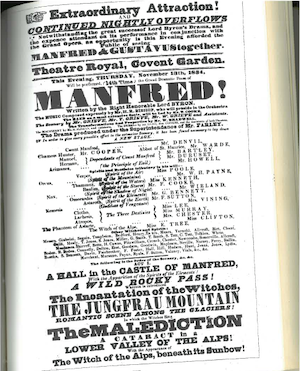
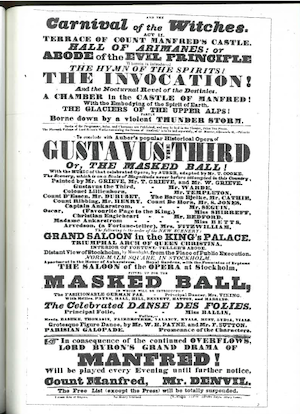
As Margaret Howell’s study of the acting version submitted to the Lord Chamberlain reveals, the settings and words were predominantly Byron’s own—incorporating the original rejected third act (Howell ch. 3). The product was less “Manfred Transformed,” as Howell titles her chapter, than “Manfred Restored”: what Gifford excised and the Works preserved but degraded to the apparatus, Bunn raised into his script. The exception was the hint of incest, which theatrical censorship forbid representing on stage, and which had been duly removed. Bunn, Howell writes, made “Astarte Manfred’s cousin and ultimately his redeemer, an alteration clearly influenced by Goethe’s Faust”—that too seems a return of the influence Byron denied (98). In this stage version Manfred neither dies defiantly nor with calm dignity: Astarte reappears to announce, “I do forgive thee!” and, the stage direction indicates, Manfred “breaks from the Abbot, rushes toward her — falls & dies” (Howell 103). Thereupon, reports the playbill, all was “Borne down by a violent THUNDER STORM” [see Fig. 6]. In his reminiscences, Bunn recalled, amid the general enthusiastic reception, a particular consequence probably made possible by the interdiction of the theme of incest: ‘It was eminently successful—applauded by a crammed auditory, lauded, with but one exception, by the press, and witnessed with an inward satisfaction and delight by the poet’s sister, the Honourable Mrs. Leigh. In a letter from this accomplished lady, she says, “Manfred was splendidly got up, and Miss Ellen Tree’s Witch of the Alps I shall dream of!” (Bunn I:146)’
In sending the revised third act to Murray, Byron commented “I certainly am a devil of a mannerist—& must leave off” (BLJ V:185). As the proliferating cantos of Don Juan demonstrate, “leaving off” was not Byron’s truest mode, especially when “leaving off” was initiated by a senior figure of authority. The contradictory impulses of the 1832 edition are faithful to Byron insofar as they present him divided between earlier and later versions of himself. The effect produced by editorial intervention in 1832 parallels the break in Don Juan between the arrested figure of Juan, who bears the traces of Byron’s childhood and scandalous separation, othered into a young Spaniard, and the narrator, who “rattle[s] on exactly as I’d walk . . . born for opposition,” fully engaged with, and brilliantly and sardonically commenting on, postwar Europe (XV.19-22). Goethe became the sage devoted to renunciation invoked by Carlyle in Sartor Resartus, contemporary with Bunn’s production of Manfred: “Close thy Byron; open thy Goethe” (Carlyle 153). Byron could not close Byron; in one of his forecasts of the development of Juan, he told Murray: “I meant to have made him a Cavalier Servente in Italy and a cause for a divorce in England—and a Sentimental ‘Werther-faced man’ in Germany—so as to show the different ridicules of the society in each of those countries,” not maturing into wisdom but “gradually gaté and blasé as he grew older—as is natural (BLJ VIII:78).
“I want a hero, an uncommon want,” he opened Don Juan: “I’ll therefore take our ancient friend Don Juan, / We all have seen him in the pantomime / Sent to the devil somewhat ere his time” (I:1). Byron’s nominal hero is a stock figure whose metamorphoses become the instrument to “show the different ridicules of the societies in each of those countries,” not a settled sage or aspirant to the status of “the Greatest man of [Europe].” Byron theatricalizes; if the production travestied him, it also caught qualities integral to him—without, however, the two voices of Don Juan or of Wright’s edition.
The zeal of Wright preserved a Byron that Murray, on the advice of Gifford, had initially repudiated; it also disseminated an exchange between Byron and Goethe over the review of Manfred by producing a literary history that never happened. On February 25, 1817, in the same letter that Byron announced to Murray from Venice that he had sent him “the other day some extracts from a kind of drama—which I had begun in Switzerland—& finished here,” he requested a favor: ‘Look into ‘Moore’s (Dr. Moore’s) view of Italy’ for me—in one of the volumes you will find an account of the Doge Valiere (it ought to be Falieri) and his conspiracy—or the motives of it—get it transcribed for me & send it in a letter to me soon—I want it—& can not find so good an account of that business here—though the veiled portrait—& the place where he was once crowned—and afterwards decapitated still exists—& are shown. (BLJ V:173-4)’ Five weeks later he repeated to Murray that “This was the thing that most struck my imagination in Venice” (BLJ V:203). The chronological conjunction indicates the closeness of Manfred and Marino Faliero, though the latter tragedy was not completed until 1820. One grows from a “Witch drama” in a Gothic setting, and the other marks a determined program to quit the extravagant “manneris[m]” (BLJ V:185) that Gifford condemned. “It appears to me,” Byron declared to Murray as the tragedy approached publication, ‘that there is room for a different style of the drama . . . good English—and a severer approach to the rules—might combine something not dishonourable to our literature, I have also attempted to make a play without love.——And there are neither rings—nor mistakes—nor starts—nor outrageous ranting villains—nor melodrame [sic]—in it. (BLJ VIII:78)’ Yet the two plays share the thematic of a world emptied of significance, figured in Manfred by the death of Astarte and in Marino Faliero by the failure of the Venetian aristocracy adequately to punish the perpetrator of a slander against Angiolina, the wife of Faliero. That failure undermines the authority of which he, as Doge, is the emblem, driving him “into conspiring against the State of which he was the actual reigning Chief,—the last circumstance,” as Byron hyperbolically put it, “makes it the most remarkable—& only fact of the kind in all history of all nations” (BLJ V:174). Manfred’s confession, “From my youth upwards / My spirit walk’d not with the sons of men,” presents his withdrawal into icy seclusion in general terms (II.ii.50-1); Faliero’s turning from a long lifetime of service to tormented alliance with disaffected plebeians against his class is painfully particular. In the revised third act, Manfred justifies his abandonment of the “noble aspirations in my youth, / To make my own the mind of other men, / The enlightener of nations” by boastfully proclaiming
I could not tame my nature down; for heMust serve who fain would sway—and soothe—and sue—And watch all time—and pry into all place—And be a living lie. (III.i.105-20)
Faliero experiences himself as having been turned into a “living lie” by the refusal of the Forty to respect ducal authority; both protagonists display the self-destructive pride of the Byronic hero—and of the narrator of Cantos III and IV of Childe Harold’s Pilgrimage, whose teasing at the borders of fiction and autobiographical revelation is extended into the oblique but recognizable domestic details of Byron’s childhood, marriage, and separation in Don Juan, which had reached Canto V by 1821.
Despite his disdain for political activity in the soliloquy that opens the fourth scene of the revised third act, Manfred is overcome by a memory of having once “stood within the Colosseum’s mighty wall, / ‘Midst the chief relics of almighty Rome . . .”
. . . till the placeBecame religion, and the heart ran o’erWith silent worship of the great of old!—The dead, but sceptered sovereigns, who stillRule our spirits from their urns. (III.iv.10-41)5
The imperial model of “almighty Rome” in Manfred yields to a parallel nearer to Britain in Marino Faliero, the maritime power of Venice, now sunk from glory to a place of Carnival and the intrigues and contretemps that fill Byron’s contemporary life, letters, and Beppo (written the same year as Manfred was completed). The degradation of authority Faliero experiences, as many commentators have noted, corresponds with the shift in political force in England from the reforming aristocratic liberals of the late eighteenth and early nineteenth century to working-class radicals such as Cobbett and Orator Hunt. The involvement of Hobhouse with the radicals, leading to his imprisonment, profoundly discomfited Byron, and despite the éclat of his entry into the Greek Revolution (and death at Missolonghi), Byron was aware that the aristocratic status he flaunted was ceding political effectiveness to organized movements.
Byron framed Marino Faliero with a Preface summarizing his sources, and an Appendix in which he printed extracts from them, in the original languages and in translation. These Wright curtailed to a dozen pages set in tiny type, but together they demonstrate the care Byron took to establish the cultural and historical context in which his characters act. The paratexts are integral to the design of the volume as a whole and connect directly to one of Wright’s most telling editorial interventions. On October 17, 1820, roughly seven months after seeing Goethe’s critique of Manfred and two months after the completing the copy of Marino Faliero, Byron sent Murray his “dedication of” the drama “to Goethe" (BLJ VII:206), countermanding his request on January 19, 1821: “Omit the Dedication to Goethe” (LJ VIII:66). In his Life of Byron (1830), republished in the 1832-1833 edition of the Works, Moore printed an expurgated text of the “never before published . . . very singular Dedication . . . written in the poet’s most whimsical and mocking mood” (V:356). Notwithstanding its previous appearance, Wright, while rebuking Moore for his excisions, reprinted Moore’s text in his preface to Marino Faliero, positioning it to lead directly into Byron’s Preface and play.
The reader of Wright’s text, and those derived from it across the nineteenth century, thus apprehends, with greater or lesser self-consciousness, the play as part of the sequence Manfred => Goethe on Manfred => Byron’s Dedication to Goethe => Marino Faliero. The exchange we experience did not happen: Goethe did not receive the Dedication until 1831, by which time Byron had been dead for seven years. Goethe died in 1832, before the appearance of the twelfth volume, containing Marino Faliero, of the Works.
In transmitting the Dedication to Murray, Byron enclosed ‘an Italian abstract of the German translation of Manfred's appendix in which you will perceive quoted what Goethe says of the whole body of English poetry (& not of one in particular) on this the Dedication is founded as you will perceive—though I had thought of it before for I look upon him as a Great Man. (BLJ VII: 206)’ Even if Goethe had not aimed solely at Byron the stricture quoted in the Dedication that “the predominant character of the whole body of the present English poetry is a disgust and contempt for life,” it provided him the occasion for a riposte against the criticisms aroused by Manfred. Moreover, the layout of Wright’s edition enfolds Manfred Faliero in the riposte.
Byron continues, exposing the point that Goethe had obscured by speaking of Manfred only in relation to Faust: ‘But I rather suspect that by one single work of prose, you yourself have excited a greater contempt for life, than all the volumes of English poesy ever written. Madame de Staël says, that “Werther has occasioned more suicides than the most beautiful woman”; and I really believe that he has put more individuals out of this world than Napoleon himself,—except in the way of his profession. (Works XII:51).’ If the reply is only a witty tu quoque, it also hints that a writer who had struggled to distance himself from his “white-hot expression of pain and joy,” as Goethe had in the post-publication embarrassments of Werther, might have been more sympathetic to the urgencies of Manfred than Goethe had been, and less ready to spread unfounded scandal about the poet’s life. The drama to which the Dedication was to be attached deepens the reply. Goethe had charged that Byron “repeatedly pourtrayed” his torment, to the point that “scarcely anyone feels compassion for this intolerable suffering, over which he is laboriously ruminating” (LJ XII:506). Marino Faliero demonstrates that Byron’s preoccupations could be turned outward into a very different world, into “Venetian history and manners” (Wright’s terms, Works XII:45) of the fourteenth century, creating a “regular” drama in “good English” (Byron’s terms, qtd. in Works XII:49) that unmistakably cast light on the shifting political conditions of a Britain that was not only post-Napoleon but also post-Peterloo. Devotees of “the Byronic” were disappointed, as Byron anticipated that they would be. Wright prints Francis Jeffrey’s verdict in the Edinburgh Review that Byron fails because he chose a story “which not only gives no scope to the peculiar and commanding graces of his genius, but runs continually counter to the master currents of his fancy” (qtd. in Works XII:46). In the drama, the passionate plaints of a Manfred yield to the goal of provoking readers to critical thinking about the civic and the personal—but the oppositions are inadequate. Marino Faliero demonstrates—to Goethe and others—that imagination can turn personal history and Venetian history alike into a work of art, one that shows, as Goethe claimed for Werther, the cultural situations that produce the self-involved protagonist. In what seems like an offhand P.S. to the Dedication, Byron writes: ‘I perceive that in Germany, as well as in Italy, there is a great struggle about what they call “Classical” and “Romantic”—terms which were not subjects of classification in England, at least when I left it four or five years ago. (Works XII:52)’ The sentence seems a mere statement of fact, or a bemused reflection. It applies, however, to the entire sequence of Byron’s own productivity from Manfred to Marino Faliero, continuous but shifting in form, not subject to a (single) classification.

